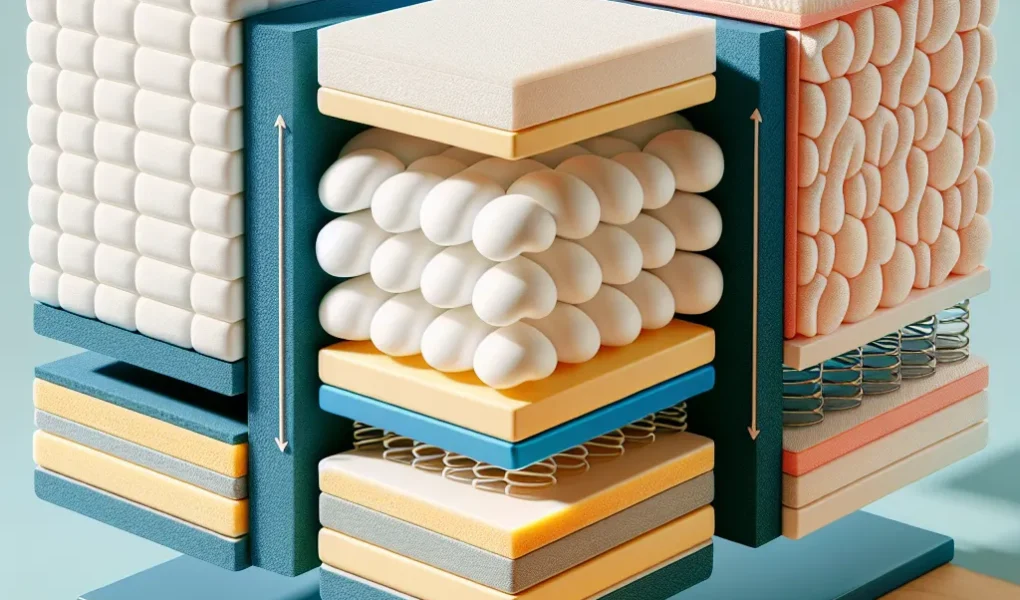Foam Mattresses vs Hybrid vs Innerspring: A Comparative Analysis
When it comes to choosing the perfect mattress, the options seem endless – foam, hybrid, innerspring. Each type comes with its own set of benefits and drawbacks, making the decision a tough one. Let’s delve into a comparative analysis of foam mattresses, hybrid mattresses, and innerspring mattresses to help you make an informed decision.
Foam mattresses are known for their exceptional contouring abilities and pressure relief. They are constructed using layers of memory foam or latex foam, providing a supportive and comfortable sleep surface. These mattresses excel in motion isolation, making them ideal for those who share a bed. On the other hand, hybrid mattresses combine the best of both worlds by incorporating foam layers with pocketed coils, offering a good balance of support and comfort. The inclusion of coils enhances airflow, making hybrid mattresses a great choice for hot sleepers.
Innerspring mattresses, characterized by their use of steel coils for support, are lauded for their durability and bounciness. They are often more affordable than foam or hybrid mattresses, making them an attractive option for budget-conscious shoppers. However, innerspring mattresses may not offer the same level of pressure relief and motion isolation as their foam and hybrid counterparts.
When it comes to longevity, foam and hybrid mattresses tend to outlast innerspring mattresses due to their superior ability to retain their shape and support over time. Additionally, foam and hybrid mattresses are better equipped to conform to the body’s natural curves, providing targeted support where needed.
In conclusion, the choice between a foam, hybrid, or innerspring mattress ultimately depends on individual preferences and needs. Are you in search of superior pressure relief and motion isolation? A foam mattress might be the best fit. Seeking a balance of support and comfort with enhanced airflow? Consider a hybrid mattress. On a tight budget and prioritize bounce and durability? An innerspring mattress could be the answer. By understanding the nuances of each mattress type, you can make an informed decision to ensure a good night’s sleep.
The Pros and Cons of Foam, Hybrid, and Innerspring Mattresses
When it comes to choosing a new mattress, consumers are often faced with the decision between foam, hybrid, and innerspring mattresses. Each type of mattress has its own set of pros and cons, making it important for buyers to carefully consider their preferences and needs before making a purchase. Let’s take a closer look at the advantages and disadvantages of each type of mattress.
Foam mattresses are known for their contouring support and pressure relief. They are excellent at isolating motion, making them a good choice for couples. Additionally, foam mattresses are often hypoallergenic, making them ideal for individuals with allergies. However, some people may find that foam mattresses retain heat, which can be uncomfortable for hot sleepers. Furthermore, foam mattresses may lack edge support, making it difficult to sit or sleep near the edge of the bed.
On the other hand, hybrid mattresses combine the benefits of foam and innerspring mattresses. They offer the contouring support of foam with the added support and breathability of innerspring coils. This combination can provide a good balance of comfort and stability for many sleepers. However, hybrid mattresses can be heavier and more expensive than other options, and they may also be more prone to motion transfer.
Innerspring mattresses, with their traditional coil support systems, are known for their strong edge support and excellent breathability. They tend to be more affordable than foam or hybrid mattresses, making them a popular choice for budget-conscious consumers. However, innerspring mattresses are often less effective at isolating motion and providing pressure relief compared to foam or hybrid options. They may also have a shorter lifespan due to the potential for coil sagging or breakage.
In conclusion, each type of mattress has its own set of advantages and drawbacks. Foam mattresses offer exceptional pressure relief but may trap heat and lack edge support. Hybrid mattresses provide a combination of foam and innerspring benefits but can be heavier and pricier. Innerspring mattresses are affordable and breathable but may lack motion isolation and durability. Ultimately, the best choice will depend on individual preferences, budget, and sleep needs.
Choosing the Right Mattress: Foam, Hybrid, or Innerspring?
When it comes to choosing the right mattress, consumers are often faced with the decision between foam, hybrid, and innerspring options. Each type of mattress offers unique benefits and considerations that can impact overall sleep quality and comfort.
Foam mattresses are known for their contouring support and pressure relief, making them a popular choice for individuals seeking enhanced comfort. The viscoelastic foam conforms to the body, providing a cradling sensation that can alleviate aches and pains. On the other hand, hybrid mattresses combine the benefits of foam and innerspring mattresses, offering the support of coils and the comfort of foam layers. This combination is designed to provide both support and enhanced breathability for a cooler night’s sleep.
Innerspring mattresses, with their traditional coil systems, offer a more responsive feel and excellent support. The coil structure promotes airflow, making them a suitable choice for individuals who tend to sleep hot. Additionally, innerspring mattresses are often more budget-friendly compared to foam and hybrid options.
Ultimately, the decision between foam, hybrid, and innerspring mattresses comes down to personal preferences, sleep habits, and specific needs. Individuals who prioritize pressure relief and body contouring may lean towards foam mattresses, while those looking for a balance of support and comfort may opt for a hybrid mattress. On the other hand, individuals who prioritize responsiveness and airflow may find that an innerspring mattress meets their needs best.
By understanding the unique characteristics of foam, hybrid, and innerspring mattresses, consumers can make an informed decision and select the option that best aligns with their individual sleep preferences.
Comparative Performance of Foam, Hybrid, and Innerspring Mattresses
When it comes to choosing a mattress, consumers are faced with a wide array of options, including foam, hybrid, and innerspring mattresses. Each type of mattress offers unique features and benefits, making the decision-making process quite challenging. In order to make an informed choice, it is important to compare the performance of foam, hybrid, and innerspring mattresses across various factors.
Foam mattresses are known for their exceptional contouring and pressure-relieving properties. They conform to the body, providing personalized support and minimizing motion transfer. On the other hand, hybrid mattresses combine the benefits of foam and innerspring mattresses, offering both support and comfort. The coil support core in hybrid mattresses provides a responsive feel, while the foam layers contribute to pressure relief.
Innerspring mattresses, on the other hand, are characterized by their traditional, bouncy feel. The coil system offers strong support and ample airflow, making them suitable for those who prefer a more traditional mattress feel. However, innerspring mattresses may not provide the same level of motion isolation as foam or hybrid mattresses.
When comparing the performance of these mattress types, factors such as support, comfort, durability, motion isolation, and temperature regulation should be considered. Foam mattresses excel in motion isolation and pressure relief, making them ideal for couples and individuals with different sleep preferences. Hybrid mattresses, with their combination of foam and coils, offer a balance of support and comfort, making them a versatile option for many sleepers. Innerspring mattresses are known for their strong support and breathability, but may not perform as well in motion isolation.
In conclusion, the comparative performance of foam, hybrid, and innerspring mattresses varies across different factors, and ultimately, the choice will depend on individual preferences and needs. Understanding the unique features of each type of mattress is crucial in making an informed decision when shopping for a new mattress.



